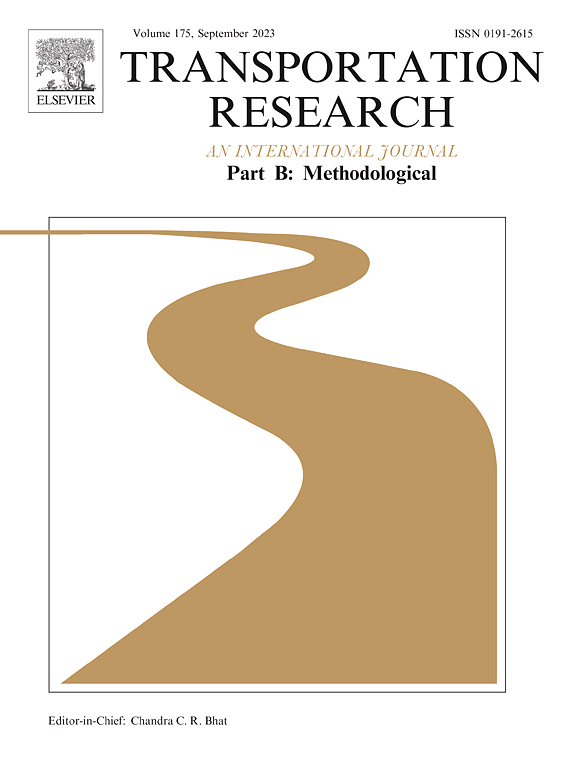Compliance-constrained resilient system optimal trajectory planning for CAVs at on-ramp intersection with multiple lanes
IF 6.3
1区 工程技术
Q1 ECONOMICS
引用次数: 0
Abstract
This paper addresses traffic merging at highway intersections (labeled as OMM intersections) where mainline traffic with multiple lanes and on-ramp traffic converges, which often represent traffic bottlenecks causing severe traffic congestion and safety issues. To do that, we developed a Compliance-constrained Resilient System Optimal Trajectory Planning (CR-SOTP), which is devised as an event-triggered rolling-horizon system-optimal trajectory planning and replanning coupled scheme combined with a compliance incentive instrument. Specifically, we developed a bi-level optimization model (C-SOTP-BL) with the upper level (SOTP-MINLP) formulated as a mixed integer nonlinear program to generate a system optimal trajectory plan for all CAVs within a trajectory planning area around an OMM intersection, subject to the compliance constraints from the lower level (C-MINLP) optimal incentive model built upon game theory. To adapt to real-time implementation, we developed a parallel computing-aided relax-enforcement-refinement (P-RER) solution method to efficiently solve the C-SOTP-BL. Thanks to the advanced computing performance of the P-RER, the CR-SOTP approach gains resilience through the coupled rolling horizon framework, which recursively plans and replans CAVs’ trajectory by solving the C-SOTP-BL with a descending scale to respond to random disturbances. Numerical experiments employing NGSIM data confirmed the effectiveness of the solution algorithm P-RER in real-time implementation, outperforming existing commercial solvers. The CR-SOTP can generate efficient and resilient trajectory plans to ensure stream-wide safe and smooth traffic merging at an OMM intersection subject to random disturbances. The experiments noticed notable enhancements in social welfare, demonstrating benefits outweigh the associated incentive cost for ensuring CAV compliance. Overall, we claim that the CR-SOTP strategy significantly improves stream-wide traffic safety, efficiency, and sustainability at multi-lane on-ramp intersections.
多车道入匝道交叉口自动驾驶车辆顺应性约束弹性系统最优轨迹规划
本文讨论了高速公路交叉路口(标记为OMM交叉路口)的交通合流,其中多车道干线交通和入口匝道交通汇合,这通常代表交通瓶颈,导致严重的交通拥堵和安全问题。为此,我们开发了一种顺应约束弹性系统最优轨迹规划(CR-SOTP),它被设计为一个事件触发的滚动地平线系统最优轨迹规划和重新规划耦合方案,并结合了顺应性激励工具。具体来说,我们开发了一个双层优化模型(C-SOTP-BL),其中上层优化模型(SOTP-MINLP)被表述为一个混合整数非线性程序,以在基于博弈论的下层优化激励模型(C-MINLP)的合规约束下,为OMM交叉口周围的轨迹规划区域内的所有自动驾驶汽车生成系统最优轨迹规划。为了适应实时实现,我们开发了一种并行计算辅助松弛执行细化(P-RER)求解方法来有效地求解C-SOTP-BL。由于P-RER的先进计算性能,CR-SOTP方法通过耦合滚动地平线框架获得弹性,该框架通过求解C-SOTP-BL,递归地规划和重新规划cav的轨迹,以响应随机干扰。利用NGSIM数据进行的数值实验证实了P-RER求解算法在实时实现中的有效性,优于现有的商业求解器。CR-SOTP可以生成高效且有弹性的轨迹规划,以确保在受随机干扰的OMM交叉路口,整个河流的安全和平稳的交通合并。实验注意到社会福利的显著提高,表明利益超过了确保CAV合规的相关激励成本。总体而言,我们认为CR-SOTP策略显著提高了多车道匝道交叉口的交通安全性、效率和可持续性。
本文章由计算机程序翻译,如有差异,请以英文原文为准。
求助全文
约1分钟内获得全文
求助全文
来源期刊
CiteScore
12.40
自引率
8.80%
发文量
143
审稿时长
14.1 weeks
期刊介绍:
Transportation Research: Part B publishes papers on all methodological aspects of the subject, particularly those that require mathematical analysis. The general theme of the journal is the development and solution of problems that are adequately motivated to deal with important aspects of the design and/or analysis of transportation systems. Areas covered include: traffic flow; design and analysis of transportation networks; control and scheduling; optimization; queuing theory; logistics; supply chains; development and application of statistical, econometric and mathematical models to address transportation problems; cost models; pricing and/or investment; traveler or shipper behavior; cost-benefit methodologies.

 求助内容:
求助内容: 应助结果提醒方式:
应助结果提醒方式:


